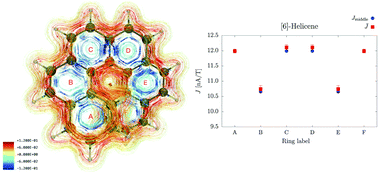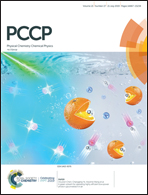Magnetically-induced current density investigation in carbohelicenes and azahelicenes†
Abstract
A computational study of the magnetically-induced current (MIC) density has been carried out for a variety of ortho fused polycyclic aromatic molecules at the density functional theory level with the gauge including magnetically induced current (GIMIC) method. With this method, the aromatic character of each ring in a homologous series of carbohelicenes with an increasing number of fused benzene rings is assessed and compared with other aromaticity criteria such as the Nucleus Independent Chemical Shift [NICS(0), NICSzz(0)] and Bond Length Alternation (BLA) parameters. All criteria indicate that the two outer rings are the most aromatic ones [i.e. higher induced current, more negative NICS(0) and NICSzz(0) values, and smaller BLA values]. For the large helicenes (n > 10), the current drops along the following four rings and then rises again. Additionally, we have proven that this behavior is not due to a difference of the local magnetic field coming from a difference of orientation of the ring with respect to the external magnetic field (oriented along the helical axis). Upon fusing additional benzene rings to form hexa-peri-hexabenzo[7]helicene, some rings (B, D, and F) are a lot less aromatic (even non-aromatic) than the others. The NICS(0) and NICSzz(0) values exaggerate this behavior because they are all positive values, which is a signature of antiaromaticity. Then, when substituting one, three, or four benzene rings with pyrrole ones to form mono-aza-[7]-helicene, tri-aza-[7]-helicene, and tetra-aza-[7]-helicene, remarkable changes in the electronic structures of the helicenes are observed. Indeed, the induced currents are always smaller in the pyrrole rings than in the benzene ones. This has been further investigated using the streamline and the color map representations, which indicate that the diatropic current density passing through the plane cutting the C–N bonds in the pyrrole rings is stronger but is more localized than the current density passing through the plane cutting the C–C bonds in the benzene rings. This gives a positive but smaller total induced current for the pyrrole rings than for the benzene ones. For these systems, the NICS(0) and even more the NICSzz(0) values are not fully reliable to probe the local aromaticity, contrary to the induced current. Indeed, the NICSzz(0) values for the tri-aza-[7]-helicene molecule range from −14.23 to 1.14 ppm, which cannot lead to the same conclusion as the induced current values (10.03 to 12.87 nA T−1).



 Please wait while we load your content...
Please wait while we load your content...